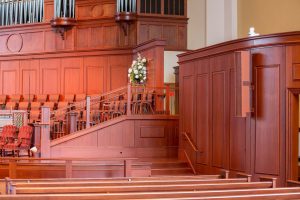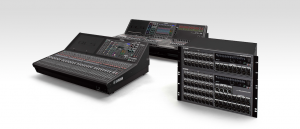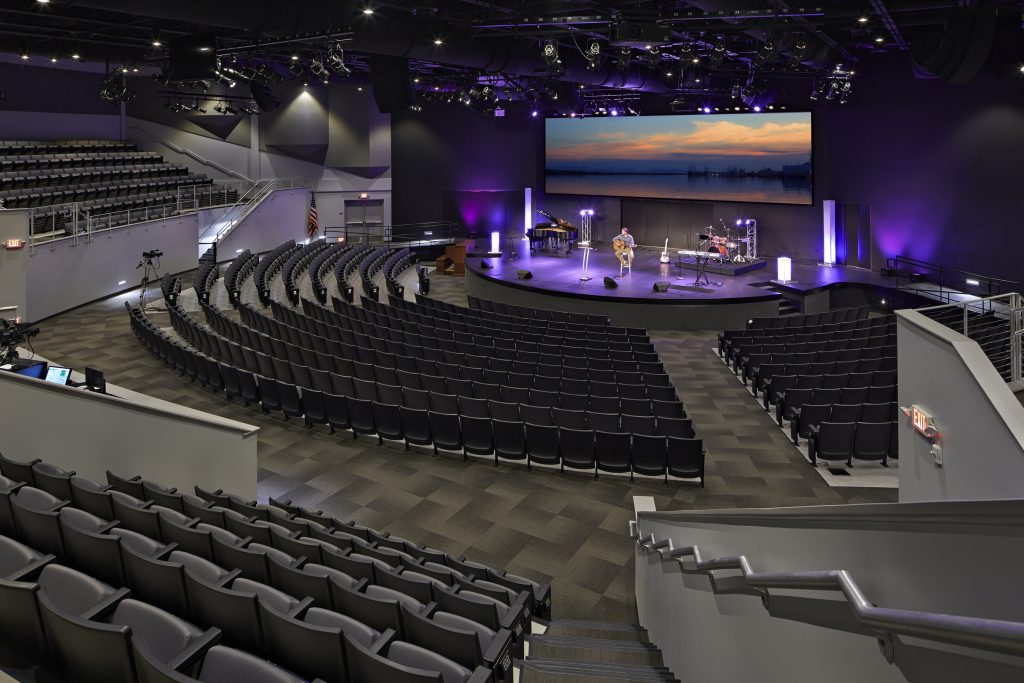 Since the completion of its expansive, 1,750-seat sanctuary in 2013, Johns Creek United Methodist Church has become a destination not only for its members, but also for the public at large. Its lush, long reverberation makes an ideal setting for musical performances of all types, from symphony orchestras to contemporary bands to solo concerts on its massive pipe organ. The church is part of what earned Johns Creek – a northeastern suburb of Atlanta, Georgia – its top-ten spot in USA Today’s 2017 “50 Best Cities to Live In.” Unfortunately, the sanctuary’s long reverb time also made for lousy intelligibility –that is, until dB Integrations, of Gainesville, Georgia, designed and installed a new Danley Sound Labs sound reinforcement system. Acoustician Tom Danley’s patented technologies allow Johns Creek UMC’s two Danley SBH10 column-form, point-source loudspeakers to deliver phase-coherent audio to the seats, with remarkably little energy splashed on the walls.
Since the completion of its expansive, 1,750-seat sanctuary in 2013, Johns Creek United Methodist Church has become a destination not only for its members, but also for the public at large. Its lush, long reverberation makes an ideal setting for musical performances of all types, from symphony orchestras to contemporary bands to solo concerts on its massive pipe organ. The church is part of what earned Johns Creek – a northeastern suburb of Atlanta, Georgia – its top-ten spot in USA Today’s 2017 “50 Best Cities to Live In.” Unfortunately, the sanctuary’s long reverb time also made for lousy intelligibility –that is, until dB Integrations, of Gainesville, Georgia, designed and installed a new Danley Sound Labs sound reinforcement system. Acoustician Tom Danley’s patented technologies allow Johns Creek UMC’s two Danley SBH10 column-form, point-source loudspeakers to deliver phase-coherent audio to the seats, with remarkably little energy splashed on the walls.
“The space itself is large: 150 feet wide by 100 feet deep, with a 40-foot balcony that spans the room,” explained Ronnie Stanford, director of sales and marketing at dB Integrations. “They had some column-form loudspeakers in there that had poor pattern control and not enough throw to make it to the back of the room. With an RT60 of 4.4 seconds and the poor pattern control of the existing loudspeakers the overall intelligibility in the room was extremely low. The church originally contacted us with the hope that we would treat the room acoustically. However, Danley’s steep pattern control can improve these kinds of situations by keeping energy off the walls and ceiling and thus reducing the reverb generated by the sound reinforcement system. So instead of messing with the acoustics, which would hurt the room’s musicality, I suggested instead that we explore replacing the sound reinforcement system with Danley boxes.”
Read more.
 Regular updates have significantly enhanced the convenience and performance of Yamaha CL and QL Series Digital Audio Consoles since the products’ initial release. As of the next firmware update, Yamaha will begin expanding the number of supported Dante devices. This announcement will take place during InfoComm 2018 at Yamaha booth #C1346.
Regular updates have significantly enhanced the convenience and performance of Yamaha CL and QL Series Digital Audio Consoles since the products’ initial release. As of the next firmware update, Yamaha will begin expanding the number of supported Dante devices. This announcement will take place during InfoComm 2018 at Yamaha booth #C1346.


 Since the completion of its expansive, 1,750-seat sanctuary in 2013, Johns Creek United Methodist Church has become a destination not only for its members, but also for the public at large. Its lush, long reverberation makes an ideal setting for musical performances of all types, from symphony orchestras to contemporary bands to solo concerts on its massive pipe organ. The church is part of what earned Johns Creek – a northeastern suburb of Atlanta, Georgia – its top-ten spot in USA Today’s 2017 “50 Best Cities to Live In.” Unfortunately, the sanctuary’s long reverb time also made for lousy intelligibility –that is, until dB Integrations, of Gainesville, Georgia, designed and installed a new Danley Sound Labs sound reinforcement system. Acoustician Tom Danley’s patented technologies allow Johns Creek UMC’s two Danley SBH10 column-form, point-source loudspeakers to deliver phase-coherent audio to the seats, with remarkably little energy splashed on the walls.
Since the completion of its expansive, 1,750-seat sanctuary in 2013, Johns Creek United Methodist Church has become a destination not only for its members, but also for the public at large. Its lush, long reverberation makes an ideal setting for musical performances of all types, from symphony orchestras to contemporary bands to solo concerts on its massive pipe organ. The church is part of what earned Johns Creek – a northeastern suburb of Atlanta, Georgia – its top-ten spot in USA Today’s 2017 “50 Best Cities to Live In.” Unfortunately, the sanctuary’s long reverb time also made for lousy intelligibility –that is, until dB Integrations, of Gainesville, Georgia, designed and installed a new Danley Sound Labs sound reinforcement system. Acoustician Tom Danley’s patented technologies allow Johns Creek UMC’s two Danley SBH10 column-form, point-source loudspeakers to deliver phase-coherent audio to the seats, with remarkably little energy splashed on the walls. Speaker placement has to some always been a black art – sound being a technology that you can’t physically “see” it’s not always a simple self-explanatory thing. If you are installing a new sound system in your facility, one of the biggest influences on sound quality that you can have is to have an industry professional “measure” the room response using proper test equipment. This will allow you to understand more about what sound does to the room – or maybe better put – what your room does to the sound. So much of the end sonic product of a room is the result the room’s shape and structure, not the choice of loudspeaker as many would think. Unfortunately, churches all too often reach for the “best sounding” (aka best marketed) loudspeaker, and the result is less than hoped. A less costly loudspeaker, properly placed in a well-treated room, will allow your loudspeaker to do what it does best – deliver sound to the listener – while having the room do less of what it is good at: adding many more “out of time” arrivals at the listener’s ear.
Speaker placement has to some always been a black art – sound being a technology that you can’t physically “see” it’s not always a simple self-explanatory thing. If you are installing a new sound system in your facility, one of the biggest influences on sound quality that you can have is to have an industry professional “measure” the room response using proper test equipment. This will allow you to understand more about what sound does to the room – or maybe better put – what your room does to the sound. So much of the end sonic product of a room is the result the room’s shape and structure, not the choice of loudspeaker as many would think. Unfortunately, churches all too often reach for the “best sounding” (aka best marketed) loudspeaker, and the result is less than hoped. A less costly loudspeaker, properly placed in a well-treated room, will allow your loudspeaker to do what it does best – deliver sound to the listener – while having the room do less of what it is good at: adding many more “out of time” arrivals at the listener’s ear.
